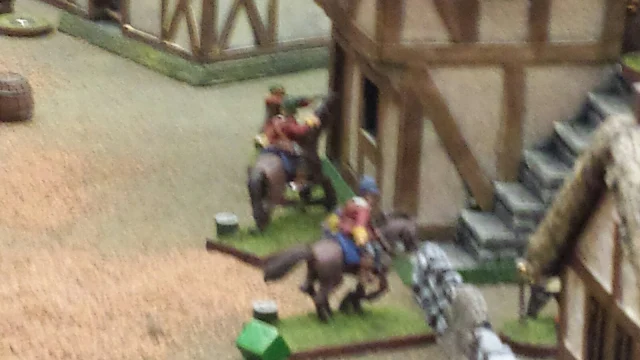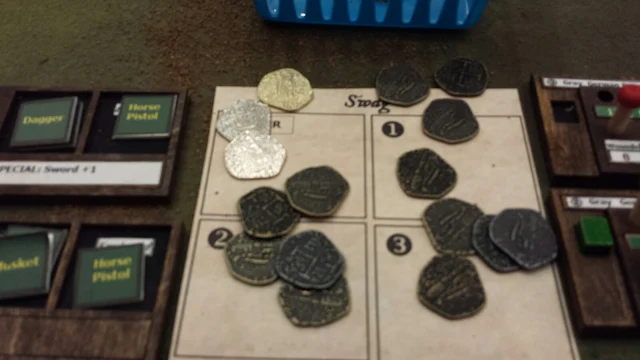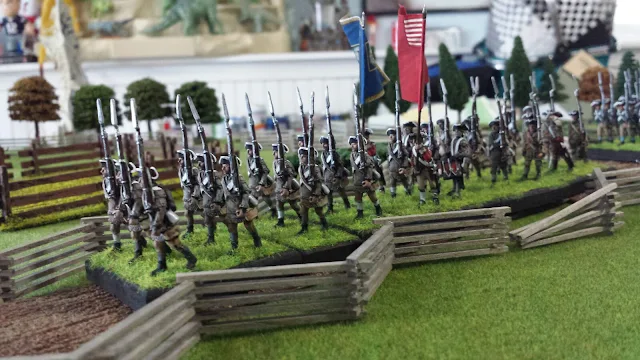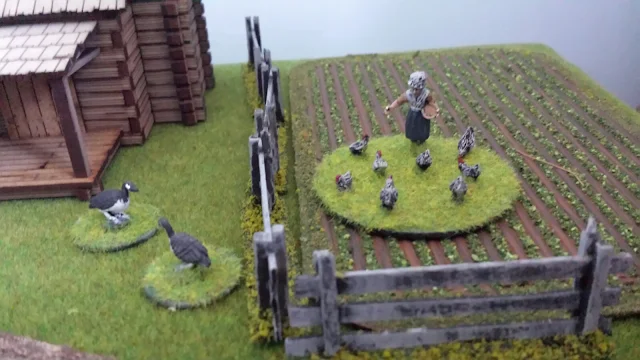Wednesday, June 27, 2018
General Alexander McDougall
Alexander McDougall was one of those renaissance men who took part in the American Revolution. They are a part of the fascination I have for this event.
Born on the Isle of Islay in Scotland in 1732 his family emigrated to New York in 1738. During his life McDougall served as a seaman, a merchant and a privateer. As a leader of the political Sons of liberty in New York city he was prominent in the events leading towards independence. During the War he raised The 1st New York Regiment and served as Major General. He commanded his brigade and fought at the Battle of White Plains in October 1776. For much of the war he commanded in the Hudson highlands and later at West Point.
After the war he served as a delegate to the Continental Congress, President of the Bank of New York and served a term in the New York State Senate.
The miniature is from Fife and Drum. I have painted him as he might have looked commanding his brigade at White Plains in 1776. He wears his old regimental uniform, but with the pink or red ribbon and cockade of a brigadier general. His faithful hound (from Warbases) adds a nice touch to the command stand.
Tuesday, June 26, 2018
1st New York Regiment 1776
The New York Provincial Congress authorized the raising of four infantry regiment in June 1775. Alexander McDougall is commissioned Colonel of the 1st New York.
In the fall of 1775 the 1st New York participates in the invasion of Canada under General Montgomery and takes part in the fighting at Saint John's and later at the failed assault at Quebec. Enlistments expire in January 1776. The regiment is reestablished with Alexander McDougall once again as Colonel.
In the spring of 1776 the 1st New York matches south to the New York city area. Once there they serve as garrison and work on the fortifications in the City. On July 4, 1776 they are assembled and the new Declaration of Independence read to the Regiment and the city.
During the Battle of Long Island they are In the reserve camp on Bayard's Hill. They are part of General Alexander McDougall brigade which includes the 1st and 3rd New York, 19th Continental and Colonel Brewer's Artificers. Later Smallwood's Maryland Regiment is added to the brigade. On October 28 the entire brigade takes part in the Battle of White Plains. After the 1st New York matches to North Castle New York. A contingent of the 1st New York joins Gen. George Washington in New Jersey and participates in the Battle of Trenton. The regiments disbanded in January 1777 and once again are restablished as the new 1st New York Regiment through 1783.
Miniatures used for the 1st New York are from Fife and Drum. Painting the Regiment posed a problem as I could not find any returns for the Regiment in 1776. Since deserter reports of 1775 and 1777 suggested blue coats faced red I went with that. The coats lined in facing material and vests in the coat color were very typical of 1776 uniforms and add a interesting touch. The regimental colors are from GMB and are very beautiful. One is the traditional New York color associated with the New York line during the Rev War. The other a simple liberty flag which was common to the period.
Thursday, June 21, 2018
Fun with 1812
I had a quiet morning before work. So I set up a table and put out some of my recent War of 1812 figures. The infantry are from Brigade games ministures. Fancy New York cavalry from Old Glory. Hunting shirt and top hat cavalry I picked up at Cold Wars and are The only figures in my collection I did not paint. Flags for the regulars are from War Flag Flags.
Sunday, June 17, 2018
Smallwood's Maryland Regiment 1776
Smallwood's Maryland Regiment was established in January 1776. Once complete it was taken On the Continental line establishment and marched New York. On 6 July 1776, the Maryland Battalion joined the main Continental Army and were assigned to Lord Stirling's Brigade. Later in August, the Maryland Battalion was reassigned to McDougall's Brigade. As part of that brigade they fought at the Battle of White Plains on 28 October 1776. From 10 December 1776 to January 1777, the Regiment was assigned to Mercer's Brigade and fought with them at Trenton and Princeton. In January 1777 they were re-designated as the 1st Maryland Regiment and assigned to the 1st Maryland Brigade on 22 May 1777 of the main Continental Army.
Smallwood's Maryland Battalion distinguished itself at the Battle of Long Island when they single-handedly covered the retreat of the American forces against increasingly superior numbers of British and Hessian soldiers. During this action the Marylanders charged the enemy six times to give their comrades time to make their way to safety. But as more British reinforcements arrived and their own casualties mounted, they finally had to give up the fight and try to get to safety themselves. Only Major Mordecai Gist and nine others managed to reach the American lines. Of the others, 256 were dead and more than 100 were wounded or captured. The bravery of the Maryland Regiment earned them the respect and admiration of their comrades. Washington was heard to say as he watched their sacrifice, "Good God, what brave fellows I just lose today. "
The dead were buried in a gravesite that is thought to be located on present day Third Avenue between 7th and 8th Streets. Until the widening of Third Avenue in 1910, the site was marked by a tablet that read: "Burial place of ye 256 Maryland soldiers who fell in ye combat at ye Cortelyou House on ye 27th day of August 1776."
Figures are from Fife and Drum miniatures. Although officers appeared to have had red faced buff uniforms enlisted men were issued hunting shirts. I decided to have The color ensigns wearing their dress uniforms rather then hunting shirts. The regimental colors are conjecture and from GMB. They are that companies usually excellent product.
Friday, June 15, 2018
3rd New York regiment 1776
The original 3rd New York regiment is raised by Colonel James Clinton for five month'sservice. They were assigned to Major General Philip Schuyler's Northern Army and toke part in the Invasion of Canada. Arriving at Quebec they join the forces under Benedict Arnold.
With enlistment expiring General Montgomery and Colonel Benedict Arnold attack in a desperate attempt to capture the city on 31 December during a blizzard. The attack fails, but the siege is maintained into spring. Enlistment expired and the regiment is disbanded.
The 3rd New York is re-raised, re-officered and rearmed for nine month's service in the spring of 1776. It is commanded by Colonel Rudolphus Ritzema (who had commanded the First New York in Canada in 1775). This version of the Regiment is composed of companies raised in the New York city area.
In New York city the regiment is assigned to Brigadier General Alexander McDougall's brigade. Uniforms, based on deserter reports are either gray or blue coats faced green as well as the usual mixture of civilian clothing. The regiment misses the battle on Long Island And takes part in the retreat northward. They form part of Washington's lines around White Plains New York in late October.
on 28 October The 1st and 3rd New York Regiments, Smallwood's Maryland Regiment, 19th Continental Regiment from Connecticut (all of McDougall's Brigade), Haslet's Delaware Regiment and Alexander Hamilton's battery reinforce two Massachusetts militia regiments on Chatterton's Hill. This is to protect Washington's right flank at White Plains. During the Battle there they repel the main British assault, but are outflanked by Rall's Hessian brigade and forced to retreat. This is the 3rd New York's first fight.
The regiment takes part in the retreat across New Jersey. On December 26 the 3rd New York takes part in the Battle at Trenton. Afterwards, enlistment up they are either discharged or recruited for the third (and final time) as the 3rd New York is again reorganized. This term to extend for three years, or the duration of the war.
I have painted the 3rd New York in it's blue coats faced and lined green. Matching waistcoat were typical of many regiments in 1776. Figures are from Fife and Drum minuatures. Flags are from GMB. As no documentation is available for this regiment At this rate I have followed Washington's advice of a regimental and national type color. These are the New York colors carried later in the War and a liberty flag which is mentioned in several Crown Forces accounts as captured during the battles around New York city.
Thursday, June 14, 2018
5th U.S. Infantry regiment 1813
The 5th US infantry regiment was raised in April 1808. During the War of 1812 the regiment took part in the fighting At Stoney Creek, Plattsburgh and Cooks mill (the final battle of the 1814 Niagara campaign).
The 5th United States Infantry regiment is dressed in the 1813 mid war uniform. The coate has a red collar and cuffs with white lace. In addition the regiment has been issued the new tombstone style shako cap. These are slight but noticeable differences from most of my collection which represents the 1814 Niagara campaign. This way I am able to add more units for a better balanced army but still be able to tell them apart.
The beautiful regimental colors are from Flags of War. They produce a beautiful yet under rated series of flags which deserve a high recognition in the wargame world. Figures are from Brigade games. Very nice figures which fit in well with my figures from Knuckleduster minuatures.
Tuesday, June 12, 2018
New project: 1776
Although quite happy with my Rev War armies up to now something was missing. Many of my favorite regiments took part in the early 1776 campaign around New York city, across New Jersey and ending with the battles of Trenton and Princeton. In fact, this campaign has long held a fascination for me. I have spent many happy hours reading about it; and have visited many of the sites associated with it. So, irrational as it appears I just had to raise a number of regiments to fight battles from this campaign.
My long term plan is to start with the American regiments. After all how can you war game this conflict and not have regiments like Haslet's Delaware or Smallwood's Marylanders in your order of battle? I was fascinated by the fight at Pell's Point after reading a report by Colonel Lamomi Baldwin so I have to add Glover' s brigade too.
Not to forget the Crown forces! I wanted addition Hessian regiments. Who better to add than Colonel Rall's hard fighting but doomed brigade made up of his regiment and the Knyphausen and Lossberg Fusilier regiments. For the British a Grenadier and Light Infantry battalion is a must. Finally a couple loyalist regiments in green coats (which is actually more correct for 1777).
For battles one could not do better then fighting Trenton after Christmas day. Not a traditional holiday activity for the entire family but let us start a new tradition! Princeton is a under appreciated action that deserves to be on the table top. The delaying action at Pell's point could be a very different game. And of course the Battle of White plains for me is a must. Must buy lots of autumn colored trees!
Figures will be from both Fife and Drum miniatures and RSM. Both lines are very similar in size and shape and fit very well together. In addition I would like to add a few Kings Mountain figures to my collection. Flags will be either computer made or bought from GMB. I like the paints from rapier I have tried recently so they are my go to paints for now.
To fund the project I already have a number of unpainted castings I have recently discovered. I also have unfinished projects I lost interest in years ago. A few American Civil War (25mmm plastic and some metal), some 1859 and 1866 Austrians (25mm and 15mm) and other miscellaneous figures will be sold or traded for new lead.
Please stay tuned for his this project works out.
Sunday, June 10, 2018
Game Night at the club
I do not always mention the club game night. This is because often i am having too good a time to make notes about the game or take pictures. Such was the case last month when I played in a fast pace and fun civil war naval game. This month it was just as fun but I did take a few pictures and notes.
If you have not yet visited Ed Meuller's blog please do. Ed combines a great sense of humor with extremely inventive wargame ideas. These came together in a wickedly fun game, " Loot the Baggage Train. " .Or, as Ed himself said; "Loot the Baggage Train!" (30 Years War): This game represents that moment so characteristic of this age when the lure of looting the baggage train overcame any interest in the battle. In this game, players will control a file of dragoons, Croats, or "Polish cossacks" as they all converge on a semi-abandoned baggage train. Loot the train; loot the other players. It's every man for himself: the player who comes away with the most swag, wins.
So it was everyman for himself and much dealing and backstabbing and bribery. Each player has four figures. Both a mounted version and dismounted version. I commanded a file of German dragoons. We all races about uncovering wagons and small cashed of loot. When you arrived at a market on the table it might have swag, or it might have nothing. Some markers contained a grenado, which could be more deadly to the thrower then the reciever.
 |
| The infamous granado |
 |
| Tossing the granado into the open window |
High point for me was discover a grenado. I used this to race up to a house, and toss it through a open windown. I was lucky in that it exploded in the house and not in my hand! Sad to say no one was in the house and no loot was found.
As to who won? That was not the point of the game. All had a wonderful time with much laughter. A perfect game night.
 |
| My bag of swag |
Monday, June 4, 2018
Mamacita and Old Squinty Eyes
 |
| What are you looking at? |
My daughter Alexandra did a art project years ago. They were two watercolors of foxes who she named Momacita and Old Squinty eyes. We have them framed in our living room. And after all these years they still being Janine and I great joy. In addition there is a fix who lives in the woods around the back of the house who we are sometimes in the late evening or early early morning.
When I was adding farm animals to my table top scenery I noticed Warbases made foxes. So I had to add them. After all with all those chickens and geese two foxes could be very happy around here!
Friday, June 1, 2018
Geese, and chickens and sheep, on my!
Continuing my theme of brightening the table top I have added more live stock to my farms. I was inspired at Cold Wars by a Sharp Practice game by 95th Division which had many unusual items scattered about the table. George and I talked about it all the way back to the Boston area.
Why geese? Why not! They get in the way of things. They make a great swaking noise and look fun being scattered by cavalry. While most of my birds are domestic, I have included two Canadian geese. After all it is the Niagara campaign.
You need sheep, and a shepard. These are based on sheep at Old Sturbridge village. Janine and I took our yorkee Fritz for a walk there last fall. While he was fascinated by all the animals (and they him) he was particularly interested in the sheep. So I added them to my farm. The Shepard is from Hovels and his loyal dog sits by. Look closely by the sheep and a rodent is scurrying away.
The lady feeding chickens I saw on Der Alter Fritz's blog . Reminded me of our farm program at Minute Man National Historical Park. We had period cows which we used to keep the grass down in the fields. At the Hartwell Tavern we had period chickens. The figure reminded me of a couple of my seasonal staff.
Lastly, we have the family cat. Note he is hard at work keeping the local rodents away from the house!
These were great fun to paint and will look good in the table. Based on a suggestion here I will be putting on a game with small cavalry units chasing each other about and collecting "forage" to bring back to the army. local militia horse will try to protect the locals. The invading horse getg points running off live stock and damaging the farms of local malcontents.
Figures were from either Hovel's or Warbases. Great service and very reasonable priced.
Subscribe to:
Posts (Atom)



































